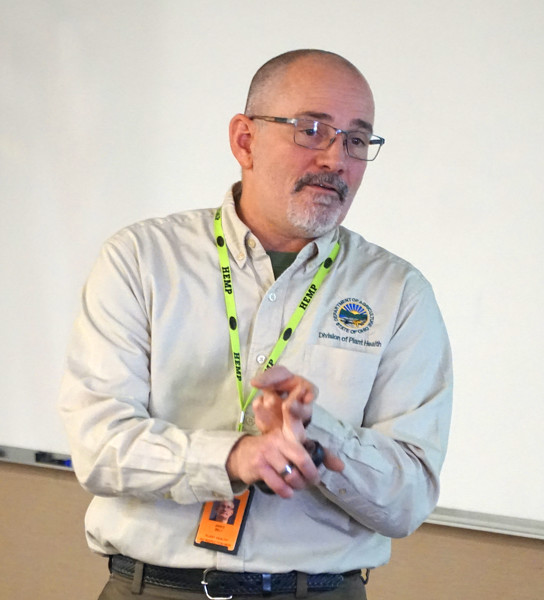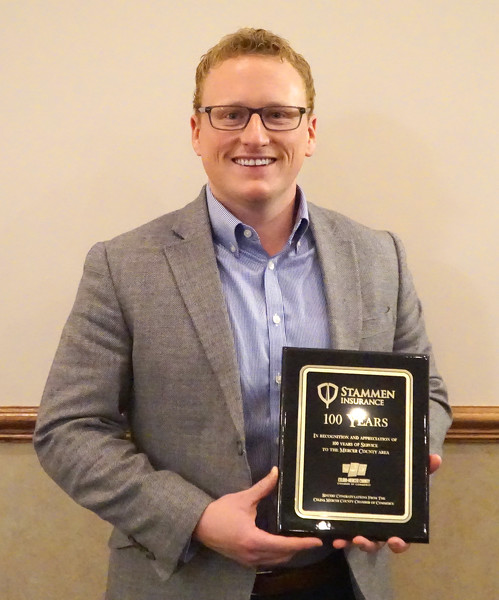Friday, March 6th, 2020
Official: Hemp growers face obstacles
By Leslie Gartrell

Photo by Leslie Gartrell/The Daily Standard
James Belt, state hemp inspection manager, on Thursday in Celina discusses Ohio's emerging hemp industry.
CELINA - While the emerging hemp industry in Ohio can seem exciting, potential cultivators should be cautious and appraise the risks when considering whether to grow the crop, according to an Ohio Department of Agriculture official.
James Belt, an ODA hemp inspection manager, discussed facets of the topic during Thursday morning's Ag Education series.
After the 2018 Farm Bill legalized hemp production, Ohio became one of the last states to approve production, Belt said, noting that Ohio did not participate in the federal pilot program as many other states had. Farmers looking to cultivate hemp must obtain an ODA license before planting.
Hemp is a strain of the cannabis sativa plant that is grown specifically for agriculture commodities, Belt said. It does not intoxicate as does marijuana. Hemp grown in the U.S. cannot test over 0.3% THC. Farmers can grow three kinds of hemp crops - one for fiber, one for grain and one that produces cannabidiol, or CBD.
Hemp is a fickle crop that is labor-intensive and requires patience and good timing, Belt said. Hemp is typically planted from mid-May to mid-June, depending on the variety. Hemp likes warm soil, according to ODA, and doesn't do well in wet soil. It can be grown on the same land for many years in succession or rotated with most preceding crops. The crop also has similar nutrient needs to corn, typically requiring annual nitrogen application.
Few pesticides are labeled for use on hemp, Belt said, and weed control is achieved mostly through cultivation and canopy cover. No herbicides are available for CBD hemp.
As a fiber, hemp can be made into rope, textiles and paper. Fiber crops are planted similarly to wheat, Belt said, but noted the crop has low demand and low returns. Hemp fiber was selling for roughly $100-$275 a ton, and farmers would need to produce about 5 tons to make a profit, he noted.
Hemp grain is high in protein and a good source of omega fatty acids, Belt said. The crop must be harvested wet and dried with forced air. It cannot be treated in corn-drying bins because it will become overheated and crack. It also needs to be moved frequently to avoid mold.
CBD hemp is planted similarly to tobacco, Belt explained. CBD hemp is a high hand-labor crop, usually cut by hand using a machete or chainsaw, according to ODA.
Farmers with a license can legally grow and process hemp in the state. The annual application window for cultivating and processing licenses is Nov. 1-March 31, although Belt noted the application window for 2020 has been extended to May 1 to accommodate first-year licensing. Licenses are good for three years, and farmers should save their money if they do not know when they would start.
All key participants, such as sole proprietors, partnership members or executive managers in a corporation, must pass a background check and be fingerprinted by the Ohio Bureau of Criminal Investigation.
The application fee for a cultivator's license is $100 and the annual license fee is $500 per growing location. A growing location is a contiguous land area or single building in which hemp is grown or planned to be grown.
Belt noted that areas separated by physical barriers that prohibit the contiguous planting of hemp outdoors must be registered as separate growing locations. Roadways, driveways, fence rows, trees or hedgerows, streams, ditches and other bodies of water are considered barriers.
Additionally, for fields that have no physical barriers within their borders, no physical gaps in planting may be greater than 20 feet wide, otherwise the grower would need to license each area separately.
Hemp can be grown only after cultivators have been approved by ODA, Belt said. An outdoor growing location must be at least one-quarter acre and have at least 1,000 plants. Indoor growing locations need at least 1,000 square feet and 1,000 plants.
Before harvesting, producers must notify ODA of their intended harvest date at least 15 days prior to ensure THC levels are below 0.3%. After ODA takes its sample, cultivators must harvest within 15 days.
However, Belt said the actual window to harvest is significantly less. If a cultivator were to take 14-15 days to harvest after the samples were taken, their crop would likely exceed the permitted 0.3% THC content because THC levels will continue to rise. Many farmers have had their crops destroyed as a result.
During Kentucky's pilot program, Belt said nearly half of all hemp was destroyed for testing over the 0.3% limit - 47%. Nationally, 25% of hemp crops in the pilot program were destroyed for testing "hot," or over the 0.3% cap.
He said farmers considering becoming licensed cultivators must heavily vet their seed producers to ensure they will not receive seeds which produce plants high in THC. He also suggested producers start with one variety of hemp for simplicity as well as avoiding additional sampling fees. Hemp genetics aren't stable compared with traditional crops, so it involves a considerable amount of risk.
Belt emphasized that people interested in hemp start small, especially if they do not have a processor in place. Ohio has no processors because the application period opened on Tuesday, he said. Indiana and other surrounding states do have processors. People should communicate with processors to understand what they want.
While hemp has spurred interest in agriculture among young people and non-traditional farmers, Belt believes it would be very risky for an inexperienced producer to attempt to grow the crop. He said he did not want to deter anyone from growing hemp but rather make sure potential cultivators know what they're facing.
"This is a new possible opportunity for agriculture in Ohio, but it is at its infancy stage here," he said. "Do not spend any more money in hemp than you can afford to lose."



